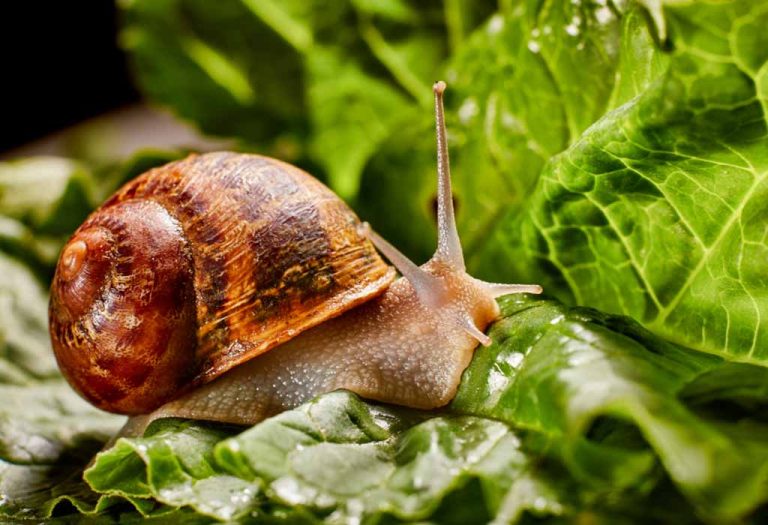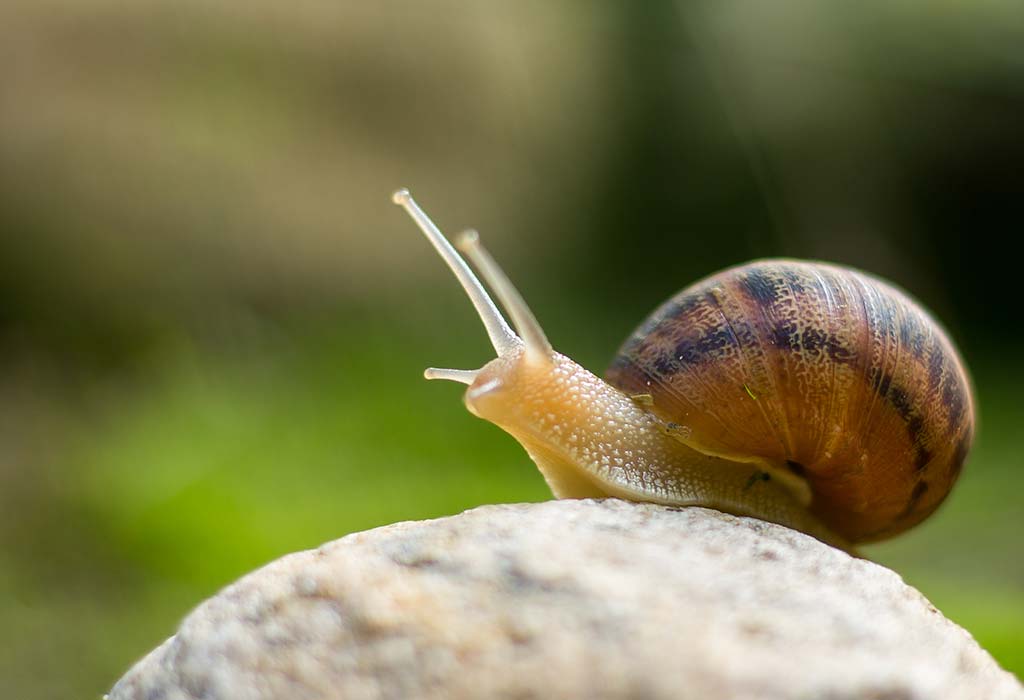Snail Facts and Information for Kids
Considered as one of the most diverse creatures on earth, snails vary in terms of their form, behaviour, and habitat. The ancestors of snails are the earliest known types of animals in the world. The fossil evidence of primitive gastropods dates back to the late Cambrian period, almost 500 million years ago. Do you have the habit of collecting empty shells by the seashore, or intrigued by how the snail retreats back into its shell at the slightest sign of danger? Then it would be scarier to know that one snail thought to be dead and displayed in a museum started moving out of its shell after hiding inside it for several years. Find out more about snail facts for kids in the following article.
Fun Facts About Snails for Children
A snail is a collective name for gastropod molluscs applied to terrestrial pulmonate and land snails. They comprise at least 150,000 species of gastropods, including sea snails, land snails, and freshwater snails that live in habitats ranging from deep open trenches, ditches, freshwater, seawater, to deserts. Snails are no different from slugs, as both are molluscs. The only measurable difference being the fact that snails have a shell. Land snails that have only a very small shell are called semi-slugs.
Whether it is escargots in France, Moroccan broth Babbouche or Nigerian pepper snails, or fried snails from Crete, edible snails are eaten as a modern delicacy or as a part of traditional cuisine in several communities around the world. Giant African land snails are produced commercially for food. Snails have been occasionally used as famine food in historical times. Muricidae snails produce a secretion that is used as a colour-fast natural dye. The high-quality protein, fat, or mineral content, such as iron and calcium, of snail meat is quite beneficial for the human body. Their shells are made into decorative objects and designer jewellery. If you’re curious about snail biology, the following information would help you to understand more about their anatomy and physiology.
1. Appearance
- Snails are invertebrates and hence do not have a backbone. A snail’s body consists of five main parts- the head, neck, visceral hump, tail, and foot.
- Snails have a ribbon-like tongue called a radula that contains thousands of tiny teeth.
- Snails have a spiral shell loaded on their back which is a hard structure that protects their internal organs.
- Snails have a strong muscular foot that allows them to crawl over rough surfaces and keep their soft bodies from drying out. The foot exudes slime, which helps the snail to move while leaving a trail behind.
- The head is attached to the foot. There are two pairs of 15mm tentacles on the head. The eyes of the snail are placed at the end of the stalks.
2. Habitat
- Snails can live in nearly every habitat on Earth. They favour moist environments such as tree bark, piles of damp waste, rotting logs, and moss.
- Snails survive dry periods by resorting to aestivation, in which they seal themselves in their shells with a layer of dried mucus.
- The preferred habitats for snails include mountain streams, foothills streams, geothermal-driven streams, flash-flooding creeks, regulated rivers, and canyon-bound streams.
- Snails are absent from the small ponds and wetlands. They can survive in a wide range of temperatures between 0 and 32 degrees centigrade, preferably in thermally stable streams.
- A wide range of New Zealand mud snails lives in the aquatic habitats of rivers, streams, reservoirs of the West, Great Lakes in the Midwest, and estuaries on the west coast.
3. Diet
- Snails are mainly herbivores and eat leaves, flowers, fruits, stems of fields, and garden crops. While larger snails and some marine-based species are carnivores or even omnivores.
- Snails mainly eat calcium-rich food that keeps their shells thick and healthy.
- Their diet may include algae, fungi, dead organic matter, and slugs.
- Ripe strawberries and tomatoes are their favourite treats.
- Red Daudebardia snail and the Sicilian predator snail eat earthworms, other snails, and insect larvae.
4. Other Facts and Information About Snails for Children
- One of the most fascinating garden snail facts is that they spend most of their lives inside their shell in winter. Their mouth remains sealed throughout their hibernation period, barring the young ones who may wake up temporarily.
- Rearing snails for human consumption is known as heliciculture.
- Angustopila dominikae is the smallest snail, measuring 0.03 inches tall, that could pass through the eye of the needle.
- Snails can be turned into musical instruments like conches or trumpets.
- Charonia tritonis is a giant triton snail that can paralyse a starfish with its venomous saliva and eat them.
- Some freshwater snails have lungs. They float up to the surface each time they need to breathe. While some have both lungs and gills.
- The mucus of the snail might be useful for healing wounds.
- Common garden snails have a maximum speed of 45 m (50 yards) per hour.
- The biggest snail is the giant African snail, with its foot measuring up to 35 cm long.
- The fastest snail is the Helix aspersa, which can reach speeds up to 0.03 mph.
- Ocean snails have colours like pink, red, blue, yellow, grey, and others. The colours protect them by scaring away potential enemies.
- Humans, fish, beetles, turtles, snakes, and insects eat snails.
- Snails move in a wave motion with their muscles passing forward along the sole of the foot.
- Snails lay a large number of eggs in moist weather. The eggs hatch in about 14-28 days in holes or a nest.
FAQs
1. What is the lifespan of snails?
Snails, on average, live for about two to five years.
2. Are snails hermaphrodites?
Yes, snails are hermaphrodites, which means that they boast both male and female reproductive cells in their bodies. Thus, they do not require mating with another snail to reproduce.
3. Do snails have eyes?
Snails typically have four tentacles, of which two have eyes on the end.
4. Do snails feel pain?
When faced with an unpleasant stimulus, mussels release morphine, and snails can show opioid-like reactions. These reactions suggest that these creatures are capable of experiencing pain. Although molluscs lack true brains, their neural systems are centralised to some extent. They possess a nerve cord that links to several pairs of ganglia.
Lack of familiarity and cultural taboos have restrained humans from eating snails on a large scale. However, today, snails are becoming the next mainstream alternative for those seeking more sustainable animal protein sources. Snails have been symbolised as the deadly sin of sloth in Christian culture. On the contrary, snails have been used in divination with the Aztec moon god Tecciztecati, bearing a snail shell on its back symbolising rebirth. The snail may have been metaphorically used to describe a slow and inefficient process in the expression ‘a snail’s pace’. However, there are plenty of other things about them to amaze. We hope you loved our collection of snail facts for kindergarten and preschoolers, and would love to know about your favourite fact about snails.
Also Read:
Insect Facts for Kids
Horse Facts for Children
Giraffe Facts for Children
Penguin Facts for Children
Ladybug Facts for Children
Ant Facts and Information for Kids
Was This Article Helpful?
Parenting is a huge responsibility, for you as a caregiver, but also for us as a parenting content platform. We understand that and take our responsibility of creating credible content seriously. FirstCry Parenting articles are written and published only after extensive research using factually sound references to deliver quality content that is accurate, validated by experts, and completely reliable. To understand how we go about creating content that is credible, read our editorial policy here.























